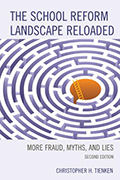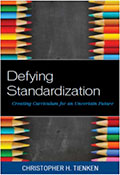Translating the Common Core State Standards
Christopher H. Tienken
Donald C. Orlich
Cross posted from the AASA Journal of Scholarship and Practice
AASA.org
Colleagues and I have been writing about our concerns with the Common Core State Standards initiative (NGA & CCSSO, 2010) since 2009 (e.g. Tienken and Canton, 2009; Tienken and Zhao, 2010).
But as Don Orlich and I (Tienken and Orlich, 2013) describe in Chapter 7 of our new book, The School Reform Landscape: Fraud, Myth, and Lies, the Common Core State Standards (CCSS) initiative continues to ramble on, without evidence to support its efficacy. That is because education reform in the United States is being driven largely by ideology, rhetoric, and dogma instead of evidence.
Sadly for today’s children, the ideas put forth via the Common Core are simply recycled from those presented by the Committee of 10 and Committee of 15 in 1893 and 1895. However, the rhetoric used by the vendors of the CCSS seemingly attempts to mask the fact that there is little that one can consider innovative or equitable in education reform’s latest product.
Translations of Standardization
Below are excerpts from our book in which we take some of the claims made by the vendors of the CCSS and provide translations of the considerations the vendors of the standards claim they made when constructing the CCSS.
Internationally benchmarked: The vendors claim that these standards are: Mirrors of standards from high-performing countries and states so that all U.S. students are prepared to succeed in a global economy and society. Translation: We copied some language from some of the best test-taking nations but we have no evidence that the ideas we copied will have any positive influence on creativity, innovation, or overall student learning in the U.S. and we have not considered any unintended consequences. We do not even match specific CCSS standards to specific countries. Thus, we leave you, educators and the general public, wondering which standards are benchmarked and to which countries those benchmarks belong.
Special populations: The standards are written with inclusionary language. Translation: The authors of the CCSS assume that the standards are accessible to various student populations and learning styles, but because the CCSS were never field tested prior to launch, the vendors do not have data to support the assertion. The vendors also fail to tell us that the national standardized tests will be driving all decision-making about special populations anyway and that all special populations will have to take the same test as non-special populations. In the end, all students will have to demonstrate mastery of all standards, at the same level of difficulty, in the same format. So much for meeting individual needs.
Assessment: We are told that the vendors of the CCSS did not develop an assessment system. The vendors do state that the CCSS will ultimately be the basis for an assessment system that would be a “national” assessment to monitor implementation. Translation: You will be tested, but we do not want to take responsibility for that. Now that most state education bureaucrats adopted the CCSS, national testing is scheduled to begin in 2014 or 2015 in 42 states. In many states, education bureaucrats will use the results from the national tests to judge the quality of the public school system and those who learn and work in it. The results will be used to determine promotion and graduation eligibility in many states. All of the NCLB waiver plans approved by the USDOE included the use of the CCSS and national assessments tied to incentives (aka: consequence) for teachers and school administrators.
Standards, not curriculum: The vendors of the CCSS correctly explain that the standards are not a set of curricula. They state that the initiative is about developing a set of standards that are common across states. The vendors claim that any specific curriculum that follows will continue to be a local responsibility (or state-led, where appropriate). In essence, they claim the illusion of local control.
Translation: Whatever rhetoric the vendors use to mask the loss of local control, it is important to remember that the national test frameworks and eventually the released test items will become the actual local curriculum due to the stakes attached to the test results. Local control will become an endangered species at that point.
For example, as soon as it is determined that algebra makes up over 60% of the national mathematics exam for high school and geometry accounts for, let’s say, 22%, you will see a massive shift in local curriculum away from geometry and more time toward algebra, regardless if the local population deems that appropriate.
21st century skills: The CCSS focused on two areas – English-language Arts and Mathematics. The vendors claim that the standards have incorporated 21st century skills where possible. Translation: We think 21st century skills consist of a narrow conception of mathematics and western English language arts. Furthermore, we, the vendors of the CCSS, have no idea how to develop authentic 21st century skills such as (1) strategizing, (2) entrepreneurship, (3) persistence, (4) empathy, (5) socially-conscious problem solving, (6) cross-cultural collaboration and cooperation, (7) intellectual and social curiosity, (8) drive, (9) risk taking, and (10) challenging the status quo. Our austere standards and testing program will only work to narrow and reduce the local curriculum to what is tested.
Customized It is Not
The CCSS vendors tend to assume that customized curriculum will be developed either by the respective states or textbook companies. In fact, most large publishers had new texts on the market soon after the CCSS were released in 2010; so much for customization at the local level.
It seemed like the publishers had the books on the shelves ready to go before the Standards were even released. Did they drive this effort? The CCSS were supposed to be drastically different that what existed, yet in a matter of weeks new “Common Core” materials were available for purchase, derived from existing texts.
Some state boards of education, like the one in New Jersey, actually mandated school district use of the Common Core less than a year after the CCSS were released. This meant that almost 600 school districts in the state began to purchase brand new texts made from recycled activities with different page numbers.
Districts were compelled to spend millions of dollars of taxpayer money on a set of standards and resources that were never tested or proven effective.
It did not matter if the school district personnel had just revised their math curricula and purchased new texts two years earlier. All that was now obsolete because the books did not say “Common Core” on the cover.
Let’s call this what it is: Another handout for the corporate textbook and test publishers. The CCSS initiative does not have anything to do with education. It has everything to do with the business of education as we detail in our book (Tienken and Orlich, 2013).
Common Core Standards: Where’s that Evidence?
We have seen many negative consequences of state mandated curriculum and assessment schemes in terms of curricular reductionism under NCLB. Results from empirical study after study reported the elimination of the arts and physical education, the over teaching of mathematics and language arts to the determinant of science, , foreign language, the arts, and other “non-core areas. The over reliance of high stakes commercially prepared state tests to monitor the implementation of standards is also well documented (Au, 2007; Booher-Jennings, 2005).
The Council of Chief State School Officers (CCSSO, 2009), one of the organizations that pushed through the development of the standards, wrote, “States know that standards alone cannot propel the systems change we need. The common core state standards will enable participating states to…develop and implement an assessment system to measure student performance against the common core state standards” (p.2). But where is the evidence of the efficacy of the standards? Where is the evidence that high stakes testing actually improves student learning in not only the subjects tested, but other important areas as well? There is none.
The Certain Crush of Standards
Campbell’s Law (Campbell, 1976) predicts what will happen: The subjects prescribed currently by the CCSS, language arts and mathematics, and eventually science, will become the most important subjects in terms of time and resources allotted to teachers. The opportunities students have to explore and delve into other subjects and educational activities, especially those seen as not academic challenging, will atrophy further.
Eventually, within three to five years of having the CCSS and the accompanying high stakes national tests, we will see the students who do not meet the arbitrary levels of achievement set in those subject areas labeled “at risk” and forced to do more work in those areas, depriving them further of the opportunities to participate in other educational activities. Those students will become the casualties of this latest form of education austerity.
We cite three to five years because that was the approximate time frame when schools across the country began to act regressively because of the NCLB curriculum and testing mandates. Perhaps, because the regressive policy infrastructure is already in place, it will happen faster.
Frankly Speaking
Let us be very frank: The CCSS are no improvement over the current set of state standards. The CCSS are simply another set of lists of performance objectives. Ohanian (1999) warned us fervently about this type of project years ago, prior to the birth of NCLB. Apparently the vendors of the CCSS did not heed her warning or simply do not care.
Author Biographies
Christopher Tienken is an assistant professor at Seton Hall University, College of Education and Human Services, in the Department of Education Leadership, Management, and Policy. His research interests include curriculum and assessment policy and practice. His latest book, with co-author Donald Orlich, is titled The School Reform Landscape: Fraud, Myth, and Lies. E-mail: Christopher.Tienken@shu.edu; website: www.christienken.com
Donald Orlich is co-author of The School Reform Landscape: Fraud, Myth, and Lies. He has published extensively and received numerous awards. He is Professor Emeritus at Washington State University. E-mail: dorlich@wsu.edu
References
Au, W. (2007). High-stakes testing and curricular control: A qualitative metasynthesis. Educational Researcher, 36(5), 258-267
Booher-Jennings, J. (2005). Below the bubble: “Education Triage” and the Texas accountability system. American Education Research Journal, 42(2), 231-268.
Campbell, D. T. (1976. December). Assessing the Impact of Planned Social Change. The Public Affairs Center, Dartmouth College, Hanover New Hampshire, USA.
Council of Chief State School Officers. (2009). Standards and accountability. Retrieved from http://www.ccsso.org/What_We_Do/Standards_Assessment_and_ Accountability.html
National Governors Association Center for Best Practices & Council of Chief State School Officers. (2010). Common Core State Standards. Washington, DC: Authors.
Ohanian, S. (1999). One Size Fits Few: The Folly of Educational Standards. Portsmouth, NH: Heinemann.
Tienken, C.H. & Orlich, D.C. (2013). The School Reform Landscape: Fraud, Myth, and Lies. Lantham, MD: Rowman and Littlefield.
Tienken, C. H. & Zhao, Y. (2010, Winter). [Editorial]. Common core national curriculum standards: More questions and answers. AASA Journal of Scholarship and Practice, 6(3), 3-10.
Tienken, C.H. & Canton, D. (2009, Fall). [Editorial]. National curriculum standards: Let’s think it over. AASA Journal of Scholarship and Practice, 6(3), 3-9.


